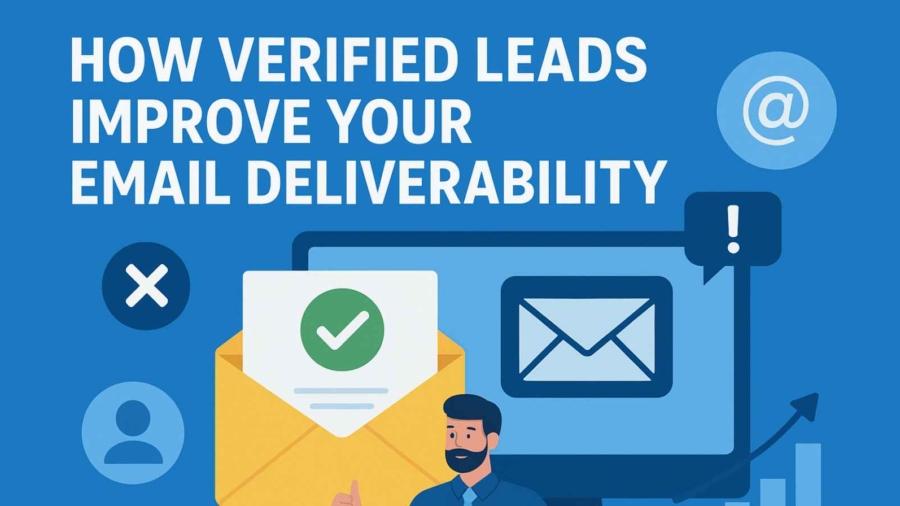Introduction
Ever sent out an email campaign only to see half of your messages bounce or land in spam? That’s a nightmare for any marketer. Email deliverability isn’t just about writing catchy subject lines; it starts with the quality of your leads. The more accurate and verified your leads are, the better your chances of reaching the inbox. Let’s break down how verified leads can dramatically improve your email deliverability and overall campaign success.
What Are Verified Leads?
Verified leads are contacts that have been checked for accuracy, validity, and activity. This means their email addresses are real, active, and belong to actual people or businesses. Unlike unverified leads, which can be outdated or fake, verified leads ensure your emails reach the right audience.
Understanding Email Deliverability
Email deliverability is the ability of your emails to reach your subscriber’s inbox without being flagged as spam. It depends on several factors:
- Bounce rates
- Sender reputation
- Engagement levels
- List quality
The truth? Your email copy doesn’t matter if your list is filled with junk.
The Link Between Verified Leads and Deliverability
How Accurate Leads Prevent Bounce Rates
High bounce rates signal to Internet Service Providers (ISPs) that you’re sending emails to invalid addresses. Verified leads drastically reduce this issue.
- Role in Sender Reputation
- ISPs rank your sender reputation based on how many of your emails get delivered, opened, or marked as spam. Verified leads protect your reputation.
- Impact on Spam Filters
- Accurate leads mean fewer spam complaints, which lowers the chances of your future campaigns being filtered out.
Benefits of Using Verified Leads
- Reduced Bounce Rate: Your messages land where they should.
- Improved Sender Score: ISPs reward responsible senders.
- Higher Engagement: More opens, clicks, and conversions.
- Better ROI: Every dollar you spend works harder.
Risks of Using Unverified Leads
If you skip verification, expect trouble:
- More spam complaints
- Risk of blacklisting
- Wasted budget on invalid contacts
In short, unverified leads are a fast way to ruin your deliverability.
How Verified Leads Improve Campaign Engagement
Verified leads aren’t just about reducing errors—they boost engagement. When your list is clean, your messages are more likely to be seen by people who actually care. This helps you:
- Build trust with ISPs
- Personalize your content better
- Strengthen subscriber relationships
Best Practices for Verifying Leads
- Double Opt-In: Confirm every subscription.
- Regular List Cleaning: Remove inactive or fake emails.
- Verification Tools: Platforms like ZoomInfoList ensure your leads are accurate and up-to-date.
Case Study: Verified Leads in Action
Imagine two marketers:
- Marketer A buys an unverified list of 10,000 contacts. Half bounce, and the rest mark his emails as spam. His domain gets flagged.
- Marketer B uses 10,000 verified leads. Bounce rate is under 1%, engagement is high, and his sender reputation improves.
The difference? Verification.
Tools for Lead Verification
- Email verification services (real-time checks)
- CRM integrations (keep data synced and clean)
- AI-driven validation (predictive accuracy and fraud detection)
The Role of Data Quality in Long-Term Success
Data quality is the backbone of sustainable email marketing. Over time, even verified leads can decay—people change jobs, abandon old emails, or switch providers. Keeping your list clean ensures consistent deliverability.
Strategies to Maintain Lead Accuracy
- Continuous monitoring to catch inactive accounts
- Re-verification cycles every few months
- Segmentation to send relevant messages to the right people
How Verified Leads Boost ROI
When you use verified leads, you save money by avoiding wasted sends. You also increase conversions because your emails actually reach decision-makers. Over time, this creates a higher lifetime value per customer.
Common Myths About Lead Verification
- It’s too expensive → Actually, it saves money by reducing wasted sends.
- My list is already clean → Even fresh lists contain errors.
- It doesn’t affect deliverability much → It’s one of the biggest factors ISPs consider.
Conclusion
At the heart of email marketing success lies one simple truth: your list is only as strong as the data it contains. Verified leads are the key to improving email deliverability, protecting your sender reputation, and maximizing ROI. If you want your campaigns to land in inboxes—and not in spam—lead verification isn’t optional, it’s essential.
FAQs
1. How often should I verify my email list?
At least every 3–6 months, or before any major campaign.
2. Can verified leads still bounce?
Yes, but the bounce rate will be significantly lower compared to unverified lists.
3. What’s the best way to verify leads quickly?
Using automated tools like ZoomInfoList for real-time verification.
4. Do verified leads guarantee inbox placement?
Not 100%, but they drastically improve your chances by reducing red flags for ISPs.
5. Where can I get reliable verified leads?
You can source them from trusted providers like ZoomInfoList.


